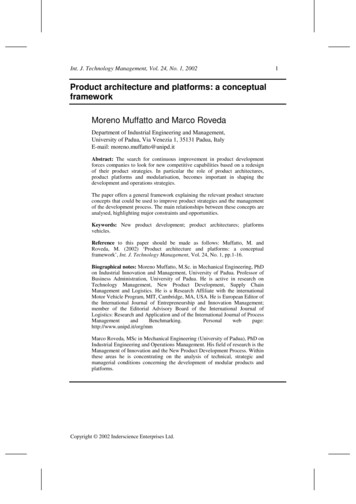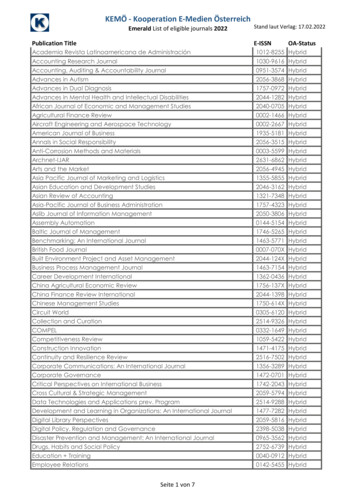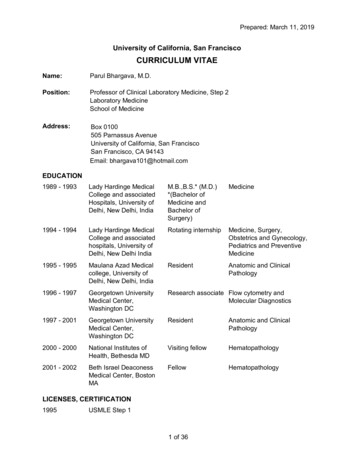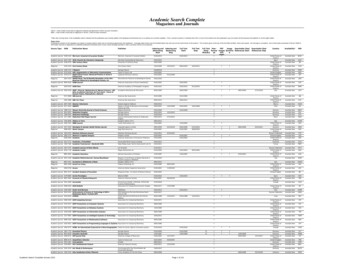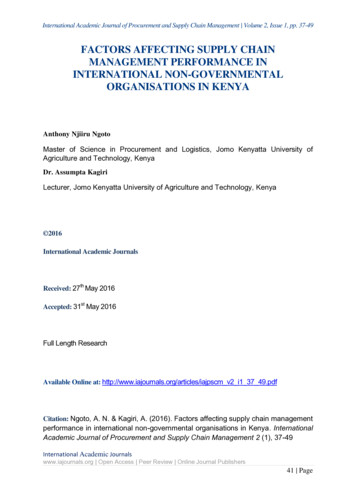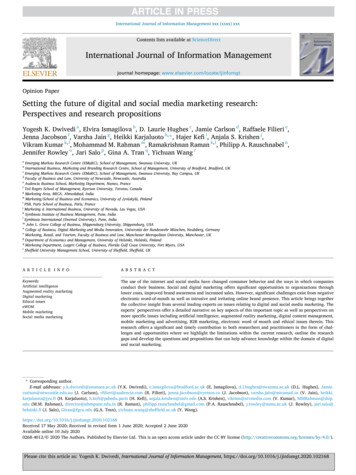
Transcription
International Journal of Information Management xxx (xxxx) xxxContents lists available at ScienceDirectInternational Journal of Information Managementjournal homepage: www.elsevier.com/locate/ijinfomgtOpinion PaperSetting the future of digital and social media marketing research:Perspectives and research propositionsYogesh K. Dwivedi a, Elvira Ismagilova b, D. Laurie Hughes c, Jamie Carlson d, Raffaele Filieri e,Jenna Jacobson f, Varsha Jain g, Heikki Karjaluoto h, *, Hajer Kefi i, Anjala S. Krishen j,Vikram Kumar k, l, Mohammad M. Rahman m, Ramakrishnan Raman k, l, Philipp A. Rauschnabel n,Jennifer Rowley o, Jari Salo p, Gina A. Tran q, Yichuan Wang raEmerging Markets Research Centre (EMaRC), School of Management, Swansea University, UKInternational Business, Marketing and Branding Research Centre, School of Management, University of Bradford, Bradford, UKcEmerging Markets Research Centre (EMaRC), School of Management, Swansea University, Bay Campus, UKdFaculty of Business and Law, University of Newcastle, Newcastle, AustraliaeAudencia Business School, Marketing Department, Nantes, FrancefTed Rogers School of Management, Ryerson University, Toronto, CanadagMarketing Area, MICA, Ahmedabad, IndiahMarketing/School of Business and Economics, University of Jyväskylä, FinlandiPSB, Paris School of Business, Paris, FrancejMarketing & International Business, University of Nevada, Las Vegas, USAkSymbiosis Institute of Business Management, Pune, IndialSymbiosis International (Deemed University), Pune, IndiamJohn L. Grove College of Business, Shippensburg University, Shippensburg, USAnCollege of Business, Digital Marketing and Media Innovation, Universität der Bundeswehr München, Neubiberg, GermanyoMarketing, Retail, and Tourism, Faculty of Business and Law, Manchester Metropolitan University, Manchester, UKpDepartment of Economics and Management, University of Helsinki, Helsinki, FinlandqMarketing Department, Lutgert College of Business, Florida Gulf Coast University, Fort Myers, USArSheffield University Management School, University of Sheffield, Sheffield, UKbA R T I C L E I N F OA B S T R A C TKeywords:Artificial intelligenceAugmented reality marketingDigital marketingEthical issueseWOMMobile marketingSocial media marketingThe use of the internet and social media have changed consumer behavior and the ways in which companiesconduct their business. Social and digital marketing offers significant opportunities to organizations throughlower costs, improved brand awareness and increased sales. However, significant challenges exist from negativeelectronic word-of-mouth as well as intrusive and irritating online brand presence. This article brings togetherthe collective insight from several leading experts on issues relating to digital and social media marketing. Theexperts’ perspectives offer a detailed narrative on key aspects of this important topic as well as perspectives onmore specific issues including artificial intelligence, augmented reality marketing, digital content management,mobile marketing and advertising, B2B marketing, electronic word of mouth and ethical issues therein. Thisresearch offers a significant and timely contribution to both researchers and practitioners in the form of chal lenges and opportunities where we highlight the limitations within the current research, outline the researchgaps and develop the questions and propositions that can help advance knowledge within the domain of digitaland social marketing.* Corresponding author.E-mail addresses: y.k.dwivedi@swansea.ac.uk (Y.K. Dwivedi), e.ismagilova@bradford.ac.uk (E. Ismagilova), d.l.hughes@swansea.ac.uk (D.L. Hughes), Jamie.carlson@newcastle.edu.au (J. Carlson), rfilieri@audencia.com (R. Filieri), jenna.jacobson@ryerson.ca (J. Jacobson), varsha.jain@micamail.in (V. Jain), heikki.karjaluoto@jyu.fi (H. Karjaluoto), h.kefi@psbedu.paris (H. Kefi), anjala.krishen@unlv.edu (A.S. Krishen), vikram@srvmedia.com (V. Kumar), MMRahman@ship.edu (M.M. Rahman), director@sibmpune.edu.in (R. Raman), philipp.rauschnabel@gmail.com (P.A. Rauschnabel), j.rowley@mmu.ac.uk (J. Rowley), jari.salo@helsinki.fi (J. Salo), Gtran@fgcu.edu (G.A. Tran), yichuan.wang@sheffield.ac.uk (Y. 168Received 17 May 2020; Received in revised form 1 June 2020; Accepted 2 June 2020Available online 10 July 20200268-4012/ 2020 The Authors. Published by Elsevier Ltd. This is an open access article under the CC BY license se cite this article as: Yogesh K. Dwivedi, International Journal of Information Management, https://doi.org/10.1016/j.ijinfomgt.2020.102168
Y.K. Dwivedi et al.International Journal of Information Management xxx (xxxx) xxx1. Introduction2. An analysis of recent literatureInternet, social media, mobile apps, and other digital communica tions technologies have become part of everyday life for billions ofpeople around the world. According to recent statistics for January2020, 4.54 billion people are active internet users, encompassing 59 %of the global population (Statista, 2020a). Social media usage hasbecome an integral element to the lives of many people across the world.In 2019 2.95 billion people were active social media users worldwide.This is forecast to increase to almost 3.43 billion by 2023 (Statistica,2020b). Digital and social media marketing allows companies to achievetheir marketing objectives at relatively low cost (Ajina, 2019). Facebookpages have more than 50 million registered businesses and over 88 % ofbusinesses use Twitter for their marketing purposes (Lister, 2017).Digital and social media technologies and applications have also beenwidely used for creating awareness of public services and politicalpromotions (Grover et al., 2019; Hossain et al., 2018; Kapoor andDwivedi, 2015; Shareef et al., 2016). People spend an increasing amountof time online searching for information, on products and servicescommunicating with other consumers about their experiences andengaging with companies. Organisations have responded to this changein consumer behavior by making digital and social media an essentialand integral component of their business marketing plans (Stephen,2016).Organisations can significantly benefit from making social mediamarketing an integral element of their overall business strategy (Abedet al., 2015a, Abed et al., 2015b, Abed et al., 2016; Dwivedi et al.,2015a; Felix et al., 2017; Kapoor et al., 2016; Plume et al., 2016; Rathoreet al., 2016; Shareef et al., 2018; Shareef et al., 2019a; Shareef, Mukerji,Dwivedi, Rana, & Islam, 2019b; Shiau et al., 2017, 2018; Singh et al.,2017; Yang et al., 2017). Social media enables companies to connectwith their customers, improve awareness of their brands, influenceconsumer’s attitudes, receive feedback, help to improve current prod ucts and services and increase sales (Algharabat et al., 2018; Kapooret al., 2018; Kaur et al., 2018, Lal et al., 2020). The decline of traditionalcommunication channels and societal reliance on bricks-and-mortaroperations, has necessitated that businesses seek best practices use ofdigital and social media marketing strategies to retain and increasemarket share (Naylor et al., 2012; Schultz & Peltier, 2013). Significantchallenges exist for organisations developing their social media strategyand plans within a new reality of increased power in the hands of con sumers and greater awareness of cultural and societal norms (Kietzmannet al., 2011). Nowadays, consumer complaints can be instantlycommunicated to millions of people (negative electronicword-of-mouth) all of which can have negative consequences for thebusiness concerned (Ismagilova et al., 2017, 2020b; Javornik et al.,2020).This study brings together the collective insights from several lead ing experts to discuss the significant opportunities, challenges and futureresearch agenda relating to key aspects of digital and social mediamarketing. The insights listed in this paper cover a wide spectrum ofdigital and social media marketing topics, reflecting the views from eachof the invited experts. The research offers significant and timelycontribution to the literature offering key insight to researchers in theadvancement of knowledge within this marketing domain. This topic ispositioned as a timely addition to the literature as the digital and socialmedia marketing industry matures and takes its position as an integraland critical component of an organisations marketing strategy.The remaining sections of this article are organized as follows. Sec tion 2 presents the overview of current debates and overall themeswithin the current literature. Section 3 presents multiple experts’ per spectives on digital and social media marketing. Section 4 concludes thepaper discussing limitations and directions for future research.This section synthesizes the existing literature focusing on digital andsocial media marketing and discusses each theme listed in Table 1 from areview of the extant literature. Studies included in this section wereidentified using the Scopus database by using the following combinationof keywords “Social media”, “digital marketing” and “social mediamarketing”. This approach is similar to the one used by existing reviewpapers on a number of key topics (e.g. Dwivedi et al., 2017, Dwivediet al., 2019a, Dwivedi et al., 2019b, Dwivedi et al., 2019c; Marriottet al., 2017; Shareef et al., 2015). Based on the classification provided byKannan and Li (2017) the overall topics were divided into four themes:environment, company, outcomes, and marketing strategies.2.1. EnvironmentThe introduction and advancement of digital technologies hassignificantly influenced the environment in which companies operate.The studies in this theme focus on the changes of consumer behavior andcustomer interactions through online media and eWOMcommunications.Consumer behavior has significantly changed due to technologicalinnovation and ubiquitous adoption of hand-held devices, directlycontributing to how we interact and use social commerce to make de cisions and shop online. The increasing use of digital marketing andsocial media has positively influenced consumer attitudes toward onlineshopping with increasing market share for eCommerce centric organi sations (Abou-Elgheit, 2018; Alam et al., 2019; Komodromos et al.2018). The increasing number of shopping channels has also influencedconsumer behavior (Hossain et al., 2019, 2020), creating a morediffused consumer shopping experience. Mobile channels have becomethe norm and are now embedded within consumers daily lives via theuse of mobile tools, shopping apps, location-based services and mobilewallets - all impacting the consumer experience (Shukla and Nigam,2018).As in traditional marketing, it is important to identify the needs ofusers as well as their perceptions and attitudes to the various forms ofmessaging and communications. Kang (2018) proposed that organisa tions seek to identify the needs of members of online communities,create special offerings that accommodate those needs and effectivelycommunicate with members to increase the satisfaction levels of onlinecommunities. The study by Bae and Zamrudi (2018) analyzed socialfulfilment aspects of social media marketing, concluding that theseTable 1Themes in digital and social media marketing research - adapted from Kannanet al., (2017).ThemesCitationsEnvironmentAbou-Elgheit, 2018; Alam et al., 2019; Algharabat et al., 2018;Arora et al., 2019; Bae and Zamrudi, 2018; Gaber et al. 2019;Gironda and Korgaonkar, 2018; Islam et al., 2018; Ismagilovaet al., 2020c ; Kang, 2018; Kim and Jang, 2019; Komodromoset al., 2018; Lin et al., 2018; Liu et al., 2018; Mandal, 2019;Mazzucchelli et al., 2018; Perez Curiel & Luque Ortiz, 2018; Seo& Park, 2018.Ang et al., 2018; Chen & Lee, 2018; Hutchins and Rodriguez,2018; Hwang et al., 2018; Kang & Park, 2018; Kusumasondjaja,2018; Lee et al., 2018; Parsons & Lepkowska-White, 2018;Tafesse & Wien, 2018; Teo, 2019.Ballestar et al., 2019; Canovi & Pucciarelli, 2019; Gil-Gonzálezet al., 2018; Iankova et al., 2019; Matikiti et al., 2018; Miklosiket al., 2019; Petit et al., 2019; Ritz et al., 2019; Roumieh et al.,2018; Tous et al., 2018; Vermeer et al., 2019.Ahmed et al., 2019; Alansari et al., 2018; Aswani et al. (2018);Hanaysha, 2018; Ibrahim & Aljarah, 2018; Mishra, 2019;Morra et al., 2018; Shanahan et al., 2019; Smith, 2018;Stojanovic et al., 2018; Syrdal & Briggs, 2018; Tarnovskaya &Biedenbach, 2018; Veseli-Kurtishi, 2018;Wong et al., 2018.MarketingstrategiesCompanyOutcomes2
Y.K. Dwivedi et al.International Journal of Information Management xxx (xxxx) xxxcharacteristics were perceived to be useful in satisfying the motivationsof consumers. The study assessed the motivations of belief, communityparticipation and psychological factors, positing these as significantmotivators of preceptive social media marketing and relevance forconsumers. Consumer attitudes towards social media can in turn influ ence attitudes towards the brand. The research undertaken in Gaberet al. (2019) investigated consumer experiences using Instagramadvertising, concluding that attitudes are influenced by consumerperception of content usefulness, entertainment, credibility and lack ofirritation from the Instagram advertisement itself.The emerging trend of targeted personal advertising has led to anincrease in privacy concerns from consumers. Gironda et al. (2018)found that invasiveness, privacy control, perceived usefulness andconsumer innovativeness, directly influenced consumer behaviorintention relating to privacy concerns. Companies should be sensitive toprivacy and the concerns of consumers as they develop their advertisingstrategies and build long-term customer relationships (Mandal, 2019).While many studies within the literature rely on consumers fromdeveloped countries, the research by Abou-Elgheit (2018) emphasizedthe importance of understanding changing consumer behavior from awider context. The study conducted research on social media marketingwithin Egypt, highlighting the importance of cognition, emotion,experience and personality aspects that can influence the consumerdecision making process and trust toward online vendors. The authorargues that different demographic, cultural, geographic and behavioralconsumer segments should be considered in companies social mediamarketing activities.Consumer voices have become more powerful due to the advance ment of social media and be heard by many people. Researchers havefocused on consumer engagement, underlying characteristics, motiva tions and impact of eWOM communications, where factors such as:brand engagement (Algharabat et al., 2018), brand image (Seo and Park,2018), self-brand image congruity (Islam et al., 2018) have influencedconsumer behavior. Consumers personal characteristics and psycho logical drivers in the form of self-esteem, life satisfaction, narcissism andneed to belong, seem to play an important role in consumers sharingintention on social media platforms (Kim and Jang 2019).eWOM communication can have a significant effect on informationadoption, consumer attitude, purchase intention, brand loyalty, andtrust (Filieri & McLeay, 2014; Ismagilova et al., 2020a, Ismagilova et al.,2020c). The study by Mazzucchelli et al. (2018) collected and analyzedsurvey data from 277 millennials and found that peer recommendationssignificantly affect customer trust and brand loyalty intention. Liu et al.(2018) concluded that expressing subjectivity within online reviews canincrease purchase intention among consumers. eWOM communicationscan yield significant benefits to organisations but also present chal lenges. Negative eWOM communications can lead to dire consequencesfor companies resulting in damaged reputation, negative consumer at titudes and resulting decrease in sales. Consumers generally respondpositively to attempts by organisations to promptly reply to negativesocial media postings where the replies are addressed individuallyrather than generic postings, thereby preserving brand reputation andtrust (Lappeman et al. 2018).The social media literature suggests that online opinion leaders playimportant role in the promotion of products and services, highlightingthe criticality of selecting the right influencers (Lin et al., 2018; PerezCuriel & Luque Ortiz, 2018). Opinion leaders can be experts, celebrities,micro-celebrities, micro-influencers, early adopters, market mavens andenthusiasts. The study by Lin et al. (2018) suggests that opinion leadersshould be used to promote the hedonic and utilitarian value of productsand services over different online forums. The research proposed fiveimportant steps in the process of utilizing influencers for promotion: 1)planning where the setting of objectives for the campaign is developedand the role of online opinion leaders is defined; 2) recognition whereidentifying influential and relevant online opinion leaders is defined; 3)alignment where the organisation matches online opinion leaders andonline forums with the products or services promoted; 4) motivationwhere the organisation identifies the reward for online opinion leadersin a way that aligns with their social role; 5) coordination - which in volves the negotiating, monitoring, and support for the opinion leaders).2.2. Marketing strategiesCompanies use numerous social media platforms for social mediamarketing, such as Facebook, Snapchat, Twitter etc. The choice ofplatforms depends on target consumers and marketing strategy. Chenand Lee (2018) investigated the use of Snapchat for social media mar keting while targeting young consumers. The study findings highlightedthat Snapchat is considered as the most intimate, casual, and dynamicplatform providing users with information, socialization, and enter tainment. The study identified that young consumers seem to have apositive attitude towards Snapchat engendering similar feelings towardpurchase intention and brands advertised on the platform.Tafesse and Wien (2018) analyzed various strategies employed bycompanies such as transformational - where the experience and identityof the focal brand exhibits desirable psychological characteristics;informational - presents factual product; service information in clearterms and interactional - where social media advertising cultivatesongoing interactions with customers and message strategies (Puto andWells, 1984; Laskey et al., 1989; Tafesse and Wien, 2018). The researchundertaken by Kusumasondjaja (2018) found that interactive brandposts were responded to more frequently than informative messagecontent. Twitter was more effective for informative appeal. The findingshighlighted that Facebook worked better for interactive entertainmentposts and that Instagram was more suitable for interactive contentcombining informative-entertainment appeals. Interactive brand postswith mixed appeals received the most responses on Facebook andInstagram, while a self-oriented message with informative appeal ob tained the least appeal (Kusumasondjaja 2018).Content marketing plays an important role in the success of mar keting communications. Aspects of the literature has argued that the useof emotions in the message significantly affects consumer behavior. Thestudy by Hutchins et al. (2018) analyzed the marketing content of elevenB2B companies. It was found that using emotions in content marketingcan lead to a competitive advantage and increased brand equity. Somestudies looked at how companies should share their videos. Ang et al.(2018) conducted a scenario-based experiment with 462 participantsand applied social impact theory to conclude that a livestreaming ori ented strategy is more authentic in the eyes of consumers thanpre-recorded videos by increasing consumers searching and subscriptionintention.Social media message characteristics are important for advertisers.For example, Hwang et al. (2018) used motivation theory within atourism context to conclude that completeness, relevance flexibility,timeliness of the argument, quality and trustworthiness of source cred ibility, have a positive impact on user satisfaction. This in turn can affectuser intention where consumers are inclined to revisit the website andpurchase the tourism product. Kang and Park (2018) found that messagestructure (interactivity, formality, and immediacy) significantly affectsconsumer behavior, such as attitude towards brand, corporate trust andpurchase intention. Companies face many challenges when developingtheir strategies for social media marketing. The study by Parsons andLepkowska-White (2018) proposed a framework to help managers todevelop and apply social media as a marketing tool. The proposedframework includes four dimensions: messaging/projecting, moni toring, assessing, and responding. Lee et al. (2018) analyzed 106,316Facebook messages across 782 companies and found that inclusion ofhumor and emotion can lead to greater consumer engagement.2.3. CompanyA number of different approaches have been adopted by3
Y.K. Dwivedi et al.International Journal of Information Management xxx (xxxx) xxxThere are negative outcomes and resulting consequences of digitaland social media marketing that need to be considered by organisations.Aswani et al. (2018) highlight that digital marketing can have a negativeeffect if performed by unskilled service providers. The study highlightsthat if marketing is not developed and managed properly, it fails toprovide benefits, destructs value, increases transaction costs, coordina tion costs, loss of non-contractible value and negative impact onlong-term benefits.organisations in the use of digital and social media marketing wherecompanies have exhibited varying attitudes to social media strategy.The study by Matikiti et al. (2018) examined factors that affect attitudeof travel agencies and tour operators in South Africa. By using ques tionnaires collected from 150 agencies the study found that there areinternal and external factors influencing attitude. Internal factors aremanagerial support and managers’ level of education. External factorsare pressure from competitors, perceived benefits and perceived ease ofuse. The study by Canovi and Pucciarelli (2019) investigated the attitudetowards social media marketing in the context of small wine companies.The study found that while the majority of winery owners recognize thesocial, economic and emotional benefits of social media, they are farfrom exploiting its full potential.The literature has identified variances in attitude to social media,depending on the size and type of the company. B2B companies tend toperceive social media as having a lower overall effectiveness as a mar keting channel and categorize it as less important for relationshipbuilding than other communication models (Iankova et al., 2019). Mo tivations such as perceived economic benefit, sense of control,self-improvement, ease of use and perceived usefulness, tend to influ ence small businesses to use social media marketing (Ritz et al., 2019).Organisations use various tools for analyzing and capturing datafrom social media and managing multi-channel communication. How ever, companies tend to lack sufficient knowledge on emerging tech nologies such as Artificial Intelligence (AI) with many organisationsexhibiting low levels of adoption and utilization of Machine Learning(ML) analytical tools (Duan et al., 2019; Gil-González et al., 2018;Miklosik et al. 2019). These technologies could be used by companies forautomated curation of brand-related social media images (Tous et al.,2018); to identify more effective sales promotional targets (Takahashi,2019); to propose personalized incentives for users (Ballestar et al.,2019) and for identifying relevant eWOM communications (Vermeeret al., 2019).3. Multiple perspectives from invited contributorsThis section is organized by employing the approach set out inDwivedi et al. (2015b; 2019c) and Kizgin et al. (2020) for presentingconsolidating experts’ contributions relating to the emerging area ofdigital and social media marketing to provide their input based on theirresearch as well as practitioner expertise. Each perspective takes theform of an overview, challenges, limitations and research gap, alongwith related research propositions or questions. The contributionscompiled in this section are in largely unedited form, expressed directlyas they were written by the experts. Although, this approach creates aninherent unevenness in the logical flow, it captures the distinctive ori entations of the experts and their recommendations related to variousaspects of digital and social media marketing (Dwivedi et al., 2015b;2019c). The list of contributions is provided in Table 2.3.1. Contribution 1 - digital marketing & humanity: from individuals tosocieties and consuming to creating - Anjala S. KrishenSeveral recent studies examine hypothesized links between human ness, or human-like physical or evolutionary characteristics and as criptions of humanity and social perceptions (e.g. Wang et al., 2019).Table 2Invited contributions related to digital and social media marketing.2.4. OutcomesThe effects of digital and social media marketing can result in anumber of positive and negative outcomes for organisations. Studieshave found that social media marketing has a positive effect on customerretention (Hanaysha (2018) and also on purchase intention in thecontext of: hotels (Alansari et al., 2018), luxury fashion brands (Morraet al., 2018) and universities (Wong et al., 2018). Digital and socialmedia marketing can have a positive effect on a company’s brand. Thiscan take the form of aspects such as: brand meaning (Tarnovskaya andBiedenbach, 2018), brand equity (Stojanovic et al., 2018; Mishra, 2019),brand loyalty (Shanahan et al., 2019) and brand sustainability (Ahmedet al., 2019). The research undertaken by Stojanovic et al. (2018)applied the schema theory and multidimensional approach to brandequity where the effect of social media communications on brand equitywas studied using survey data of 249 international tourists. The resultsidentified a positive effect of the intensity of social media use on brandawareness and intention to engage in eWOM communication. Studieshave found that social media can have a significant influence on brandloyalty, sustainability and business effectiveness (Ibrahim & Aljarah2018; Veseli-Kurtishi 2018).Studies have considered consumer engagement as an outcome ofsocial media marketing. The study by Syrdal and Briggs (2018) proposedthat engagement should be considered as a psychological state of mindand should be considered separately from interactive behavior whichincludes liking and sharing content. While the majority of studiesconsider the effect of social media marketing and digital marketing oncommercial companies, some studies focused outcomes relating tonon-profit organisations. Smith (2018) examined the use of Facebookand Twitter in the context of non-profit organisations and the outcomesas well as impact on user engagement, concluding that users responddifferently to social media activities across platforms.Contribution titleAuthor(s)Digital marketing & humanity: Fromindividuals to societies and consumingto creatingLeveraging social media to understandconsumer behaviorUnderstanding and cultivating engagedconsumers in digital channelsB2B Digital and social media marketingFuture direction on developing metricsand scales for digital contentmarketing which aims to fosterconsumers’ experience and customerjourneyElectronic Word of Mouth (eWOM)Anjala S. Krishen, University of NevadaLas Vegas, USAReflections on social media marketingresearch: present and futureperspectivesAugmented reality marketing:Introducing a new paradigmResponsible artificial intelligence (AI)perspective on social media marketingHow AI would affect digital marketing?A practitioner viewDyad mobile advertising framework forthe Future Research Agenda:marketers’ and consumers’PerspectivesResearch on mobile marketingCrossing to the dark side of social anddigital marketing: Insights andresearch avenuesEthical issues in digital and social mediamarketing4Gina A. Tran, Florida Gulf CoastUniversity, USAJamie Carlson, University of Newcastle,AustraliaJari Salo, University of Helsinki, FinlandMohammad Rahman, ShippensburgUniversity, USARaffaele Filieri, Audencia BusinessSchool, FranceJenny Rowley, Manchester MetropolitanUniversity, UKPhilipp A. Rauschnabel, Universität derBundeswehr München, GermanyYichuan Wang, University of Sheffield,UKVikram Kumar and RamakrishnanRaman, Symbiosis Institute of BusinessManagement, IndiaVarsha Jain, MICA, IndiaHeikki Karjaluoto, University ofJyväskylä, FinlandHajer Kefi, PSB - Paris School ofBusiness, FranceJenna Jacobson, Ryerson University,Canada
Y.K. Dwivedi et al.International Journal of Information Management xxx (xxxx) xxxHumanness, or lack of dehumanization, is associated with the possessionof sophisticated cognitive and agentic capacities and emotional andexperiential responsiveness (Deska et al., 2018). Humanity and hu manness, while intertwined, are not synonymous. Humanity is notsimply defined as a collection of human beings; it is also characterizedby the enactment of compassion, sympathy, generosity, kindness, andbenevolence (c.f. Krishen and Berezan, 2019). In this age of digitizationand analytics, societies are grappling with intersections –human-computer, human-machine, and human-human (race, religion,sexuality, gender, ethnicity, country-of-origin, etc.), among others. Ateach of these intersections lies another challenge for humanity, espe cially in relation to digital vulnerability. Research is needed to furtherunderstand how digital marketing relates to humanity. To grow thisbody of research, we offer three aspects of individuals as dimensions oftheir humanity: (1) individuals as seekers of capital, including infor mation
m John L. Grove College of Business, Shippensburg University, Shippensburg, USA n College of Business, Digital Marketing and Media Innovation, Universit at der Bundeswehr München, Neubiberg, Germany o Marketing, Retail, and Tourism, Faculty of Business Law, Manchester Metropolitan University, Manchester, UK





